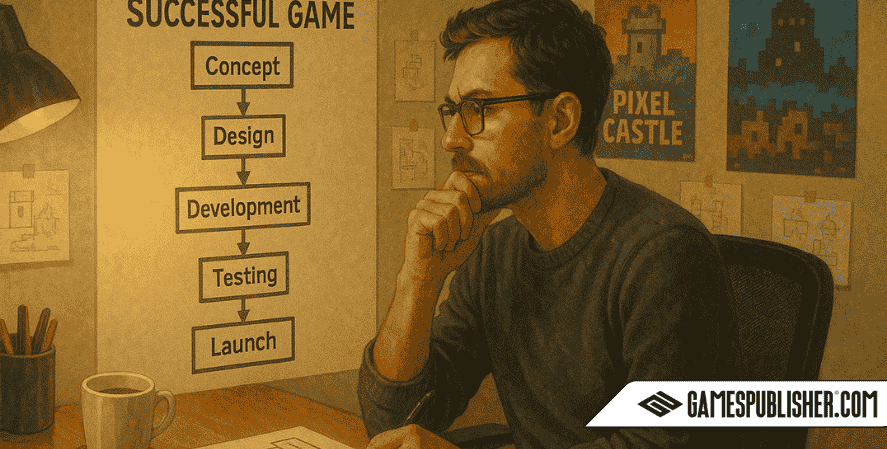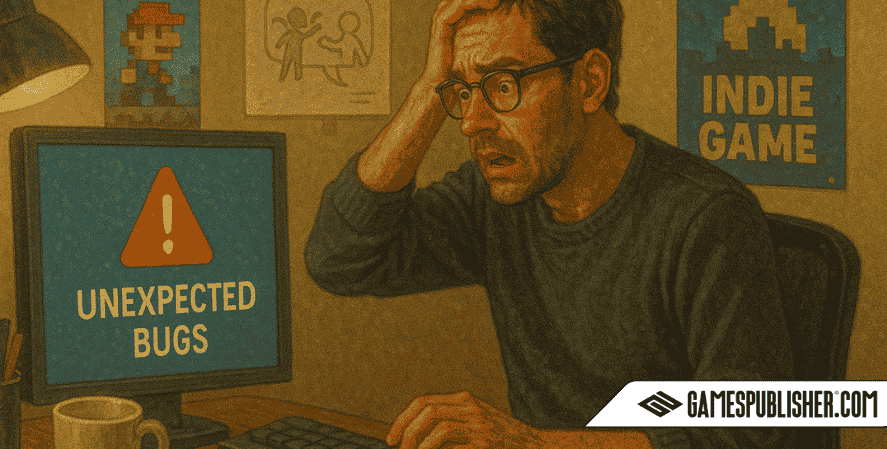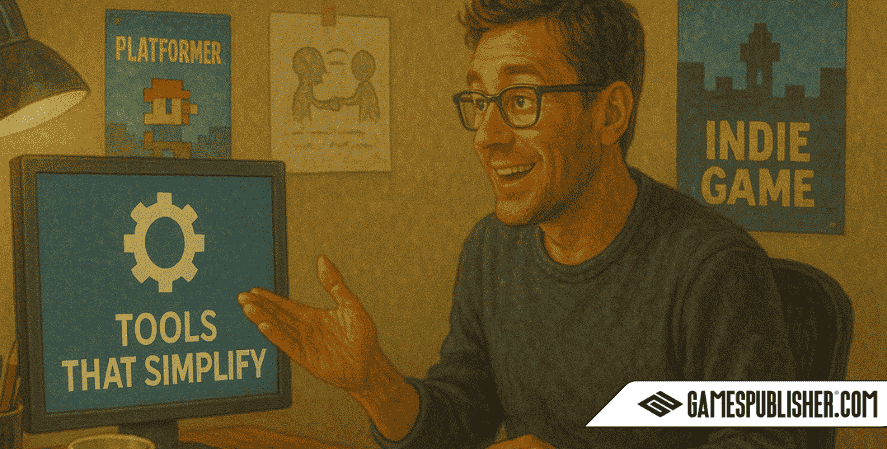The Steps in Game Development from Concept to Launch are more than just a checklist—they are the foundation of every successful game. Whether you are building an indie title or managing a AAA release, understanding each phase of the game development process can help you work smarter, avoid costly delays, and create an experience players will love.
At Gamespublisher.com, we’re passionate about supporting developers and publishers alike. In this comprehensive guide, you’ll discover how to take your game from an initial idea all the way to global launch. Additionally, we’ll explore tools, common pitfalls, and even how artificial intelligence for games is shaping development in exciting new ways.
Let’s get started.
Steps in Game Development from Concept to Launch

To build a game successfully, developers follow a series of core phases. Each stage of the game development cycle is crucial, and skipping one can put your project at risk. Therefore, it’s important to plan carefully and approach each step with intention.
Step 1 – Conceptualization: The First Phase in Game Development
All compelling games start with a creative idea that sets everything in motion. This first step is all about shaping your idea into something worth building.
Key Activities in Conceptualization:
- Brainstorm Creatively: Use prompts, team discussions, or sketchbooks to generate ideas.
- Choose a Game Genre Wisely: Popular video game genres include puzzle, RPG, and survival. Each comes with unique expectations.
- Research the Market Thoroughly: Analyze the most successful video game titles and most successful indie games to identify trends.
- Define a Unique Selling Proposition (USP): Ask yourself what makes this game different?
As a result, you’ll start to see your vision come into focus. Moreover, having a clear concept early on will make all future steps more efficient.
Step 2 – Building a Game Design Document (GDD) to Guide Your Vision
Once your idea feels solid, the next step is turning it into a clear plan. At this point, the Game Design Document (GDD) becomes an essential planning tool. Essentially, it acts as a blueprint for your entire team.
A Strong GDD Should Include:
- Game Mechanics: How players move, interact, and progress.
- Narrative and Characters: Who are they? What’s the story?
- Art and Sound Guidelines: Define style, tone, and atmosphere.
- User Interface and Experience Design: Strong UI and UX help make the gameplay smoother and more user-friendly.
- Monetization Strategy: Will it be premium, freemium, or ad-supported?
- Target Platforms: Decide if your game is for PC, mobile, console or all three.
Furthermore, this document keeps everyone aligned and minimizes confusion later in the game development cycle.
Step 3 – Prototyping: Testing Ideas in the Game Development Process
Before full development begins, it’s wise to create a simple prototype. This allows you to test your game’s core mechanics without wasting resources.
Tools Commonly Used for Prototyping:
- Unity: Ideal for 2D and 3D games across platforms.
- Unreal Engine: Great for high-quality visuals and effects.
- Godot: A free, open-source engine growing in popularity.
In addition, this stage is a good time to experiment with features like ai npc behavior or basic generative AI in game development. By doing so, you can ensure the gameplay is both functional and fun before investing more time.
Step 4 – Production: The Heart of the Game Development Cycle
At this point, the real building begins. This phase involves multiple departments working together to create a playable game.
Key Aspects of Production:
- Programming: Developers write the logic behind the game.
- Art Creation: Designers make characters, objects, and environments.
- Animation and Sound Design: These elements add life to your world.
- UI and UX Development: Clean menus and interfaces matter. Strong ui and ux design keeps players engaged.
- Integration: Assets are imported into the game engine and made functional.
Meanwhile, it’s crucial to maintain strong communication between teams. Therefore, using project management tools like Trello or Jira is highly recommended.
Step 5 – Quality Assurance: Testing the Game Thoroughly
No matter how great your concept is, bugs and glitches can ruin the player experience. That’s why testing is an essential step in the steps in game development.
Types of QA Testing:
- Unit Testing: Individual components are tested on their own.
- Integration Testing: Ensures different systems work together smoothly.
- Alpha Testing: Conducted within the team, this testing phase uncovers key issues early in development.
- Beta Testing: External testers provide feedback in real-world scenarios.
Additionally, games with complex systems, such as those involving ai npc game mechanics, need extra attention. In conclusion, good QA leads to higher player satisfaction and fewer post-launch complaints.
Step 6 – Game Marketing and Community Building
Contrary to popular belief, marketing doesn’t start after the game is finished. In fact, promoting your game early can build hype and attract valuable feedback.
Effective Marketing Strategies:
- Social Media Campaigns: Share art, devlogs, and updates.
- Community Engagement: Start a Discord or subreddit.
- Influencer Outreach: Let streamers test early builds.
- Press Kits and Trailers: These help gain coverage on websites and YouTube.
- Steam Page Optimization: Use tags and keywords smartly.
As a result, your game will have an audience before it even launches. Also, studying past video game marketing and game marketing campaigns can reveal best practices to follow.
Step 7 – Publishing and Distribution: Releasing Your Game to the World
Now it’s time to bring your game to market. This phase involves choosing where and how to publish your title.
Publishing Options:
- Self-Publishing: Offers more control but requires handling everything.
- Partnering with Game Publishers: A video game publisher can handle distribution, legal, and marketing.
Distribution Platforms Include:
- Steam and Epic Games Store for PC
- App Store and Google Play for mobile
- Xbox, PlayStation, and Nintendo eShop for console
Moreover, working with video game publishers can be a strategic move for studios looking to scale. Therefore, consider both the pros and cons carefully.
Step 8 – Post-Launch Support: Sustaining Success Beyond Release
Finally, launching the game is not the last step. Ongoing support keeps players engaged and loyal.
Post-Launch Activities:
- Patching and Bug Fixes: Solve problems as they arise.
- Content Updates and DLCs: Add value with seasonal content.
- Community Feedback: Engage players and adjust accordingly.
Additionally, offering timely updates can help increase longevity and build a strong brand. As a result, your player base remains active and invested.
Common Challenges in the Game Development Process

Even with the best planning, challenges can arise. Fortunately, knowing what to expect can help you handle these issues more effectively.
Time and Budget Overruns in Game Development
Game projects frequently exceed both time and budget expectations.
Why It Happens:
- Poor Estimation: Teams often underestimate how long tasks will take.
- Feature Creep: New features are added mid-development.
- Unexpected Bugs: Fixing one issue sometimes creates others.
Therefore, sticking to your original scope and setting realistic deadlines is key.
Communication Problems in Development Teams
Miscommunication is one of the top reasons projects fall behind schedule.
How to Fix It:
- Use tools like Slack, Trello, or Jira.
- Hold weekly stand-ups to align teams.
- Keep the Game Design Document updated for reference.
Furthermore, clearly defining roles and responsibilities can eliminate confusion early on.
Market Misalignment: A Hidden Risk in Game Development
Creating a game that no one wants is a risk all developers face.
Ways to Stay Aligned with the Market:
- Monitor trends in game genres and video game genres.
- Look at what helped the most successful indie games stand out.
- Use surveys and community polls for direct feedback.
In contrast to chasing trends blindly, aim to strike a balance between originality and familiarity.
Tools That Simplify the Steps in Game Development from Concept to Launch

Fortunately, modern tools can make the steps in game development easier and more efficient at every level.
Game Engines and Frameworks for Streamlined Development
Selecting the most suitable game engine can greatly influence your project’s outcome.
Top Engines:
- Unity: Versatile and beginner-friendly.
- Unreal Engine: Best for cinematic experiences.
- Godot: Lightweight and free.
- RPG Maker: Great for 2D narrative games.
Moreover, many engines support features like artificial intelligence for games, including tools for ai npc development and procedural content.
Project Management Tools for Organized Development
Staying organized is half the battle.
Recommended Tools:
- Trello: Visual boards for simple project tracking.
- Jira: Enterprise-grade software for large teams.
- HacknPlan: Designed specifically for game development workflows.
Additionally, these tools reduce miscommunication and help you stay on schedule.
Version Control Systems: Protecting Your Game Assets
Backing up your work and managing code changes is essential.
Best Options:
In addition to preventing data loss, version control allows multiple game developers to collaborate efficiently.
Case Study: How Indie Devs Apply the Steps in Game Development from Concept to Launch
To illustrate how these steps work in practice, let’s look at a real example from a small indie team.
The Team:
- 4 members: programmer, artist, writer, and audio designer
- Tools: Unity, Trello, GitHub
Timeline Breakdown:
- Month 1–2: Concept creation and market research
- Month 3: Game Design Document completed
- Month 4–8: Built a prototype and began production
- Month 9: Beta tested with early community access
- Month 10: Marketed via Twitter, Discord, and YouTube
- Month 11: Launched on Steam
- Month 12+: Rolled out DLC and support updates
In summary, by following each step carefully, the team minimized risks and maximized results.
Conclusion: Why the Steps in Game Development from Concept to Launch Matter
Understanding the Steps in Game Development from Concept to Launch gives creators the clarity and structure they need to succeed. From dreaming up a concept to publishing and supporting your game post-launch, each phase plays a crucial role in your overall success.
Here at Gamespublisher.com, our mission is to support developers, publishers, and creative teams at every stage of their journey. Use this guide as your development roadmap, and you’ll be far more prepared for the complex—but rewarding—journey ahead.
Loading survey...

